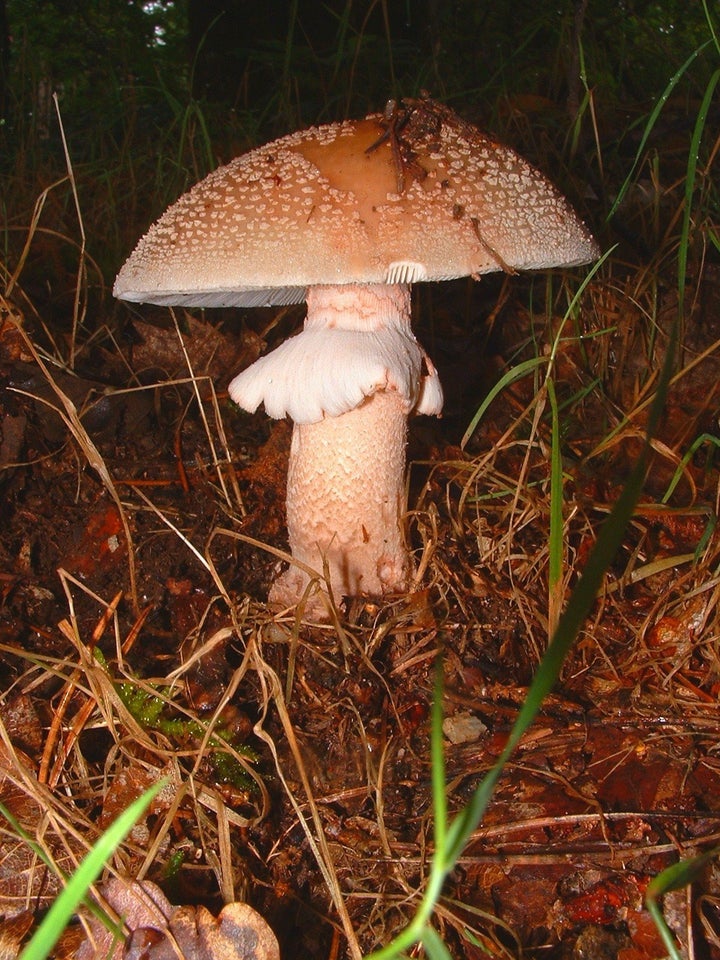
WASHINGTON -- Four D.C.-area mushroom-eaters have been hospitalized in recent weeks for eating poisonous fungi. Which leads to the question: Which mushrooms should local mushroom-foragers be avoiding?
Ray LaSala, who consulted with Georgetown University Hospital on one of the recent mushroom poisonings, is president of the Mycological Association of Washington -- a group devoted to all things fungi. LaSala told The Huffington Post that mushroom toxicity is a relative thing -- he once got hives from eating a perfectly edible honey mushroom (in fact, he got the hives twice -- after recovering from one itchy bout, he decided to eat some more honey mushrooms to see if he'd have another allergic reaction. He did). Similarly, some people have extreme alcohol sensitivity from eating morels. "People eat magic mushrooms," LaSala said. "Those are considered toxic."
That said, there are highly toxic D.C.-area mushrooms should avoid. A common one is Chlorophyllum molybdites, a "beautiful white mushroom" that "looks delicious and apparently tastes pretty good, too," LaSala said. This mushroom comes out after hot, muggy, rainy weather, and, about 75 percent of the time, it makes people sick -- really, really, sick. "It won't kill you but it'll make you wish you were dead," LaSala said.
"Why is it only 75 percent?" LaSala asked. "I don't think we know. It might be due to the population of the mushrooms. It might be due to the sensitivity of the people."
Another common local mushroom that will make your stomach hurt a whole lot, but likely won't kill you, is the Omphalotus olearius (also known as the jack o'lantern mushroom). This mushroom grows in clusters on dead wood, and is orange, "sort of like the color of a pumpkin," said LaSala. "The problem with that mushroom is that if you don't know what you're doing, and you're really naive, and really stupid, and really eager to be eating wild mushrooms, you might think that you have golden chanterelles."
LaSala said the mushroom Amanita bisporigera, also known as the destroying angel, was to blame for at least one of the recent poisonings. This mushroom is deadly toxic -- among the most poisonous mushrooms. People from Southeast Asia are especially prone to being poisoned by these mushrooms, because destroying angels, not found in Southeast Asia, look a lot like an edible paddy-straw mushroom that is found in Southeast Asia. It appears that this kind of cultural confusion is responsible for some of the D.C.-area's recent poisonings.
LaSala said he'd also heard about Amanita phalloides -- a.k.a. the death cap -- being involved with some of the recent mushroom poisonings as well.
Other mushrooms that have been implicated in the recent poisonings aren't actually toxic -- or at least not wholly so, said LaSala. One of these is Suillus granulatus -- a mushroom that is edible, but is sometimes described as poisonous. "That is only because it has a really slimy skin on the top of the cap, and if you eat a lot of that slimy skin you're going to get diarrhea," said LaSala. "You just peel off that capped cuticle and the rest of the mushroom is fine."
Similarly, Amanita rubescens -- the blusher mushroom -- which the poisoning victim whose case LaSala consulted on was said to have eaten. This mushroom is poisonous if eaten raw, but the poisoning victim supposedly grilled the mushroom. "If you cook that mushroom it's edible and delicious," said LaSala. "I've eaten it many times."
LaSala recommended two websites for more information about mushroom identification -- Mushroomexpert.com and The North American Mycological Association -- but cautioned that looking at a website, even a very good website, won't provide all the information a new mushroom-hunter needs to forage and eat safely. For that, LaSala said, it's best to spend time with people who know mushrooms.
This Sunday from noon until 5 p.m. the Mycological Association of Washington is hosting a mushroom fair at the Brookside Gardens Visitor Center (1800 Glenallan Ave., Wheaton). The fair, which is free, will feature cooking demonstrations and foraging, as well as a display of about 200 wild mushrooms.
Even with knowledge, mushroom hunting brings risks. LaSala himself ended up in the hospital once, after a mushroom-hunting trip. "I got bitten by a copperhead snake," he said. " Just one more thing to watch out for when picking wild mushrooms."

